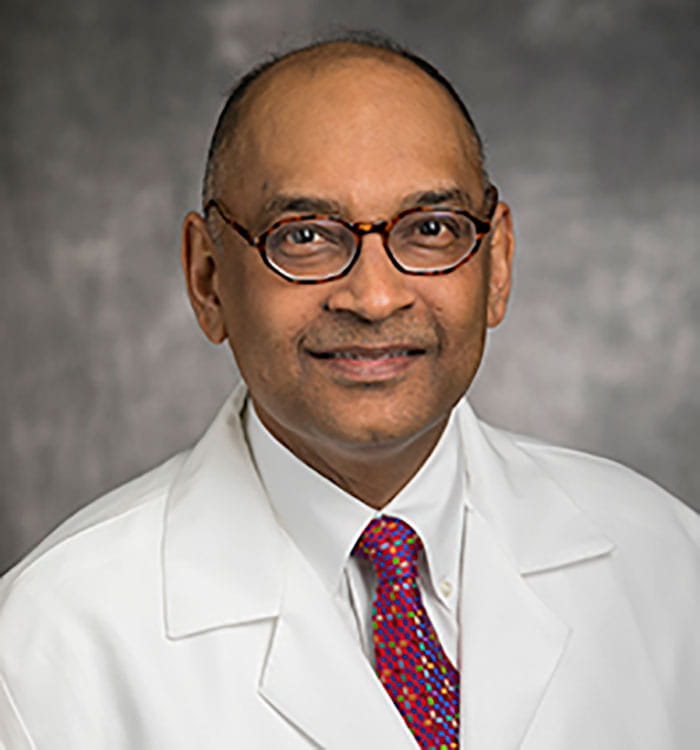University Hospitals Ophthalmologist Offers Surgical Patients a Better Experience
October 28, 2020
He offers unusual face-up recovery for patients undergoing vitrectomy for a macular hole
UH Clinical Update | October 2020
Once people are older than 60, their eyes are at a higher risk for suffering a macular hole. A macular hole can also be a result of extreme nearsightedness, a detached retina or an injury to the eye. In any case, untreated, blindness would result.
 Shree Kurup, MD, FACP
Shree Kurup, MD, FACPThe macula is located in the center of the retina, and it gives us the sharp vision we need for such tasks as reading and driving, explains Shree Kurup, MD, FACP, who is UH Director of Vitreoretinal Diseases & Surgery, and Chief of Ocular Immunology & Uveitis at the UH Eye Institute. So a macular hole would result first in blurriness in a defined area of the field of vision, and eventually in serious vision loss.
“A macular hole is basically like having a piece of jelly pulling the paint off a screen, the paint being the retina,” says Dr. Kurup, who did his residencies – one in internal medicine and another in ophthalmology - at New York Medical College after getting his medical degree from Calicut Medical College in India. “You will lose a central portion of your vision.”
Only rarely will a macular hole seal itself with no treatment. Most often, a surgical procedure called a vitrectomy is necessary. In this procedure, which is a specialty of Dr. Kurup’s, vitreous gel is removed from the eye to prevent it from pulling on the retina, and it is replaced with a bubble containing a mixture of air and gas. The bubble acts as a kind of temporary bandage while the hole closes.
The surgery itself – usually done outpatient under local anesthesia - is not painful. The difficult part for most patients comes during the recovery. During healing, he or she would have to remain face down at all times, for at least a week or two. Remaining in that position would cause the bubble to press against the macula until it was reabsorbed, and by then the eye would refill with its natural fluids. Maintaining the face-down position was considered absolutely crucial to the surgery’s success.
Post-op patients of Dr. Kurup, however, have not had to endure this. Since he began performing this surgery in 2004, all of his patients have been able to recover face-up.
Robert Reusser, 78, lives in Rocky River and runs an executive search business. For the most part, his vision was fine, though he used reading glasses. Then he noticed something odd with his left eye. “If I looked at a square, it was as if it was pinched on both sides,” he said.
He knew this was serious. Because two years earlier, he’d had retinal surgery on his right eye and endured the “face-down” recovery.
“I actually rented a periscope so that I could read in that position,” he says, because there was nothing else to distract him visually for hours on end. He also had to use a special face mask and a pillow under his chest; his body ached for weeks after being in this awkward position, 24 hours a day, for three weeks.
This time, he had an appointment with Dr. Kurup, who, to Reusser’s immense relief, told him how different his recovery would be.
Dr. Kurup explains why this approach works without the recovering patient being prone, which he too describes as an incredible ordeal.
“This idea was not mine, it has been around for years,” says Dr. Kurup, and it only takes an adjustment in approach.
“The hole in the macula is toward the back of the head. So we put gas in the eye, and get it to occlude, to block the hole as it heals. If you fill the eye full and carefully with gas, it will form a balloon, essentially, that is big enough to block everything. The hole heals, even when the patient is face up, or sitting or standing.
“It works.”
For Reusser, there was no comparison. “It was a breath of fresh air to heal this way.”
To contact Dr. Kurup for more information, email at Shree.Kurup@UHHospitals.org or call the UH Eye Institute at 216-844-8447.
Tags: Eye, Ophthalmology


